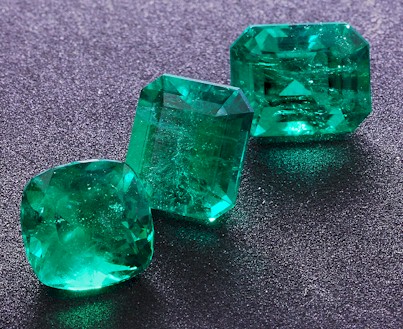The color (hue) of Emeralds ranges from yellowish green to bluish green, with most Emeralds having a very slightly bluish green color. This color is very distinct and recognizable as "emerald green". The tone (lightness or darkness) of this color can range from very light to very dark. The clarity of Emeralds can range from transparent to opaque; the opaque Emeralds are not considered to be of gem quality and may be fashioned into cabochons, instead of faceted gemstones.
 Emeralds exhibit double refraction, meaning they refract light in two different patterns. This often causes the Emerald to exhibit two different distinct color patterns, usually being a green primary body color with a bluish green secondary color, which adds to the visual beauty of the Emerald. This phenomenon, present in gemstones that have measurable birefringence (double refraction), is known as pleochroism. Pleochroism is the ability of a gemstone to present two (or more) distinctly different colors in visual observation.
Emeralds exhibit double refraction, meaning they refract light in two different patterns. This often causes the Emerald to exhibit two different distinct color patterns, usually being a green primary body color with a bluish green secondary color, which adds to the visual beauty of the Emerald. This phenomenon, present in gemstones that have measurable birefringence (double refraction), is known as pleochroism. Pleochroism is the ability of a gemstone to present two (or more) distinctly different colors in visual observation.
Refractive index is a means of measuring how the Emerald "bends" light, utilizing a refractometer designed for gemstone evaluation. Because the Emerald has natural double refraction, the refractive index is usually reported as two values. The first value is approximately 1.577 (range is +/- 0.017) and the second value is approximately 1.583 (range is +/- 0.017). The difference between these two values, known as the birefringence, is 0.006 and can be as low as 0.005 and as high as 0.009.
The green color of Emeralds comes from the presence of trace quantities of chromium (usually) and vanadium, and sometimes both. Emeralds that are sourced from Colombia are colored primarily from the presence of chromium. By observing an Emerald through a Chelsea filter, the presence of chromium can be verified by the Emerald becoming red or reddish.
Emeralds that do not contain chromium (Zambian and Brazilian origin, some others) may be colored by vanadium (and possibly iron) will not necessarily turn red or reddish when observed through a Chelsea filter. More detailed spectral mapping of the presence of chromium, vanadium, and iron can be made by evaluating the absorption spectra presented by a spectroscope. This analysis is often useful in determining the source of the Emerald.

Colombian emeralds will typically be the most expensive followed by Brazilian and Zambian stones. The reasoning is related to the color. Colombian emeralds get their color primarily from the trace amounts of the element chromium which is responsible for some of the purest greens in gemstones. Brazilian emeralds get their color primarily from trace amounts of the element vanadium and Zambian emeralds get their color from iron. Brazilian emeralds typically have a slight brown or gray cast and only sometimes match the pure green hue that many Colombian emeralds offer and Zambian emeralds often appear too blue due to their iron content. In reality though, emeralds from all three sources may be colored by more than one element.
All trademarks and logos shown herein are the property of their respective owners. © Copyright Multicolour Gems Ltd, 1998-2001. All rights reserved. Use of this site constitutes acceptance of Multicolour Return Policy, Privacy Policy and Trading Guarantee. Multicolour.com headquarters at # 59 Soi Pradit, Silom Soi 20, Bangkok, 10500, Kingdom of Thailand, Tel: +66 2 233-2108, Fax: +66 2 236-5274, E-mail to info@multicolour.com. Lost? Check Site Map. Site design and maintenance by NetComposite ®.
|